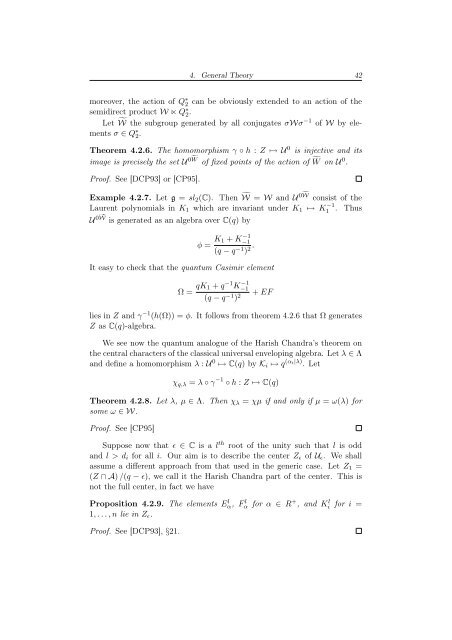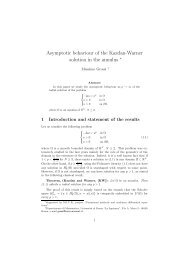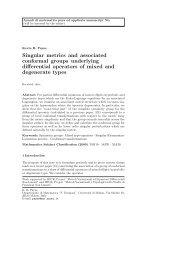Degree of Parabolic Quantum Groups - Dipartimento di Matematica ...
Degree of Parabolic Quantum Groups - Dipartimento di Matematica ...
Degree of Parabolic Quantum Groups - Dipartimento di Matematica ...
You also want an ePaper? Increase the reach of your titles
YUMPU automatically turns print PDFs into web optimized ePapers that Google loves.
moreover, the action <strong>of</strong> Q ∗ 2<br />
4. General Theory 42<br />
can be obviously extended to an action <strong>of</strong> the<br />
semi<strong>di</strong>rect product W ⋉ Q∗ 2 .<br />
Let W the subgroup generated by all conjugates σWσ −1 <strong>of</strong> W by elements<br />
σ ∈ Q∗ 2 .<br />
Theorem 4.2.6. The homomorphism γ ◦ h : Z ↦→ U 0 is injective and its<br />
image is precisely the set U 0W <strong>of</strong> fixed points <strong>of</strong> the action <strong>of</strong> W on U 0 .<br />
Pro<strong>of</strong>. See [DCP93] or [CP95].<br />
Example 4.2.7. Let g = sl2(C). Then W = W and U0W consist <strong>of</strong> the<br />
. Thus<br />
Laurent polynomials in K1 which are invariant under K1 ↦→ K −1<br />
1<br />
U 0W is generated as an algebra over C(q) by<br />
φ = K1 + K −1<br />
−1<br />
(q − q−1 .<br />
) 2<br />
It easy to check that the quantum Casimir element<br />
Ω = qK1 + q−1K −1<br />
−1<br />
(q − q−1 + EF<br />
) 2<br />
lies in Z and γ −1 (h(Ω)) = φ. It follows from theorem 4.2.6 that Ω generates<br />
Z as C(q)-algebra.<br />
We see now the quantum analogue <strong>of</strong> the Harish Chandra’s theorem on<br />
the central characters <strong>of</strong> the classical universal enveloping algebra. Let λ ∈ Λ<br />
and define a homomorphism λ : U 0 ↦→ C(q) by Ki ↦→ q (αi|λ) . Let<br />
χq,λ = λ ◦ γ −1 ◦ h : Z ↦→ C(q)<br />
Theorem 4.2.8. Let λ, µ ∈ Λ. Then χλ = χµ if and only if µ = ω(λ) for<br />
some ω ∈ W.<br />
Pro<strong>of</strong>. See [CP95]<br />
Suppose now that ǫ ∈ C is a l th root <strong>of</strong> the unity such that l is odd<br />
and l > <strong>di</strong> for all i. Our aim is to describe the center Zǫ <strong>of</strong> Uǫ. We shall<br />
assume a <strong>di</strong>fferent approach from that used in the generic case. Let Z1 =<br />
(Z ∩ A) /(q − ǫ), we call it the Harish Chandra part <strong>of</strong> the center. This is<br />
not the full center, in fact we have<br />
Proposition 4.2.9. The elements El α, F l α for α ∈ R + , and Kl i for i =<br />
1, . . .,n lie in Zǫ.<br />
Pro<strong>of</strong>. See [DCP93], §21.








